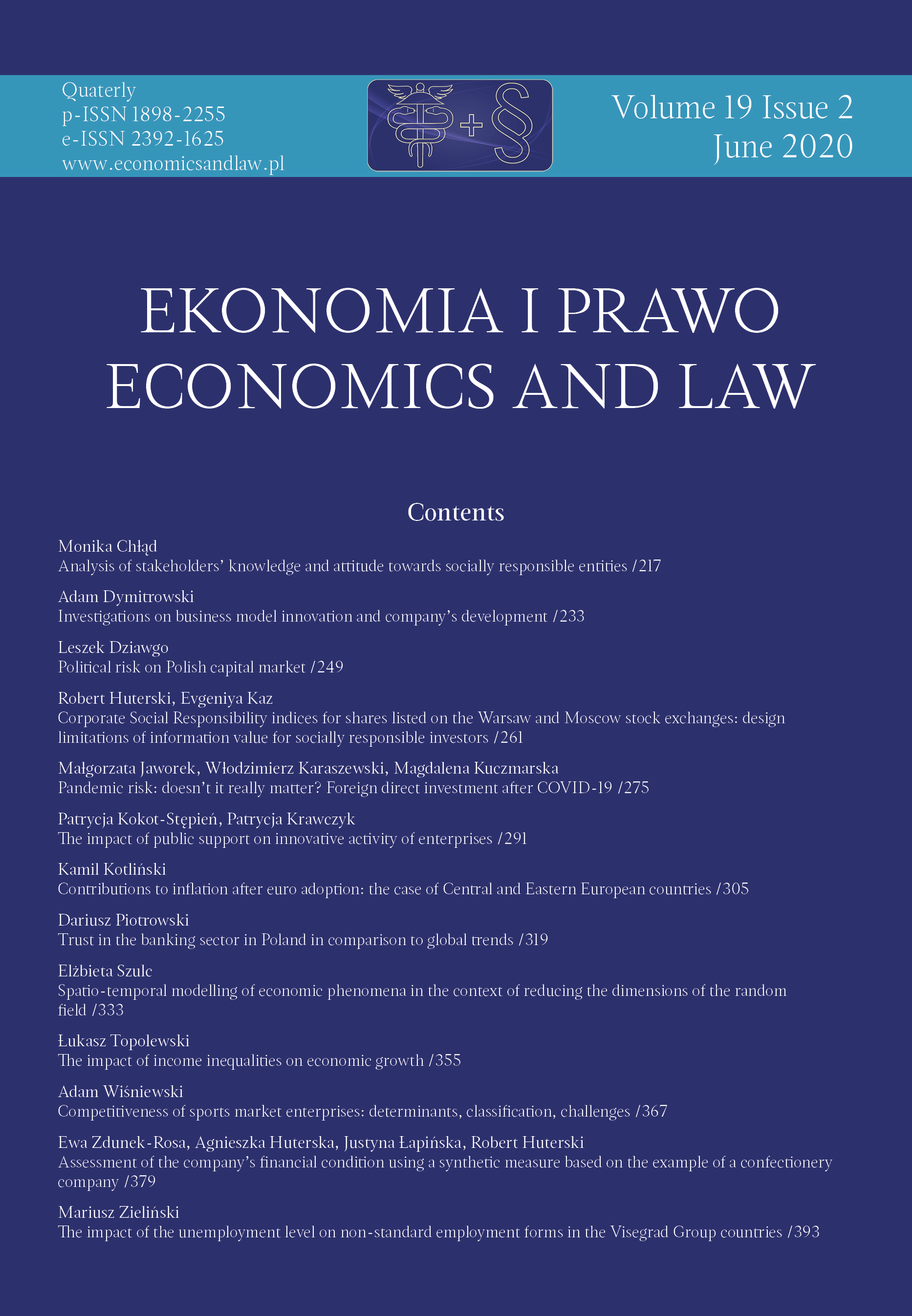Competitiveness of sports market enterprises: determinants, classification, challenges
DOI:
https://doi.org/10.12775/EiP.2020.025Keywords
competitiveness, management, sports clubs, determinantsAbstract
Motivation: Over recent years, dynamic development of new sectors and industries has been observed. As research conducted in 2004 shows in the entire European Union, sport generated 407 billion EUR of value added, which is 3.7% of GDP of the entire EU. At the same time, it generated 15 million jobs, which is 5.4% across the EU. According to the Report of the Ministry of Sport and Tourism presented in 2010 named Rachunek Satelitarny Sportu dla Polski, in the 2006 in Poland, the total value of demand for sports goods and services was PLN 20.7 billion. This is equivalent to the share of GDP in total Polish GDP in 2006 at 1.96%. Increasing the number of entities on the sports goods and services market mainly on the supply side resulted in increased competition and the need to devote their attention to elements related to competitiveness.
Aim: This paper aims to present the main determinants, analyze and attempts to classify sports market entities in team-played disciplines. The study included subjects competing in the field of volleyball.
Results: As a result of the study, conclusions regarding the manner of their rivalry and the instruments of competition used for this purpose were presented. A group of factors shaping a competitive position was listed. One of the major conclusions was statement that clubs competitive position can only be measured in terms of sport results. This is due to the fact that there are different priorities in shaping the budget. Part of the sport entities may focus on maximizing the budget while some maximize profit. The paper is the starting point for further research on competitiveness on the sports market to be gradually extended by further disciplines.
References
Chalip, L. (2006). Toward a distinctive sport management discipline. Journal of Sport Management, 20(1). doi:10.1123/jsm.20.1.1.
Dimitrov, D., Helmenstein, C., Kleissner, C., Moser, B., & Schindler, J. (2006). Die makroökonomischen effekte des sports in Europa. Retrieved 02.01.2020 from http://www.sportministerium.at.
Doherty, A. (2013). Investing in sport management: the value of good theory. Sport Management Review, 16(1). doi:10.1016/j.smr.2011.12.006.
Fahlen, J., & Stenling, C, (2018). (Re)conceptualizing institutional change in sport management contexts: the unintended consequences of sport organizations’ everyday organizational life. European Sport Management Quarterly, 19(2). doi:10.1080/16184742.2018.1516795.
Garbarski, L., (1997). Wybór rynku docelowego przez przedsiębiorstwa w warunkach konkurencji. In K. Zbytniewska (Ed.), Marketing jako czynnik i instrument konkurencji. Warszawa: SGH.
Green, B.C. (2001). Leveraging subculture and identity to promote sport events. Sport Management Review, 4(1). doi:10.1016/S1441-3523(01)70067-8.
Leeds, M., & von Allmen, P. (2004). The economics of sports. Boston: Addison-Wesley.
McEwan, K., Weston, N., & Gorczynski, P. (2018). Differentiating identities within an extreme sport: a case study of mountain biking print advertisements. Frontiers in Psychology, 9. doi:10.3389/fpsyg.2018.01668.
Nimakorn, C., Samahito, S., & Kutinatara, I. (2013). A business model development for a professional women’s volleyball league in Thailand. ABAC Journal, 33(1).
Porter, M.E. (1990). The competitive advantage of nations. London: Macmillan.
Robertson, J., Eime, R., & Westerbeek, H. (2019). Community sports clubs: are they only about playing sport, or do they have broader health promotion and social responsibilities? Annals of Leisure Research, 22(2). doi:10.1080/11745398.2018.1430598.
Senge, P.M. (2012). Piąta dyscyplina. Warszawa: Wolters Kluwer.
Stankiewicz, M.J. (2005). Konkurencyjność przedsiębiorstwa: budowanie konkurencyjności przedsiębiorstwa w warunkach globalizacji. Toruń: TNOiK.
Waśkowski, Z. (2012). Instytucjonalna struktura biznesu sportowego: ujęcie modelowe. Zeszyty Naukowe Uniwersytetu Ekonomicznego w Poznaniu, 220.
World Economic Forum. (1994). Global competitiveness report 1994. Retrieved 02.01.2020 from https://www.weforum.org.
Zhao, Y., & Zhu, L. (2015). Research on the Chinese sport industry and related policy guided beneficial pattern: theoretical analysis and novel perspective. In L. Liu, & J. Shi (Eds.), Proceedings of the 1st International Symposium on Social Science. Wuhan: Atlantis Press. doi:10.2991/isss-15.2015.27.
Downloads
Published
How to Cite
Issue
Section
Stats
Number of views and downloads: 1140
Number of citations: 0
